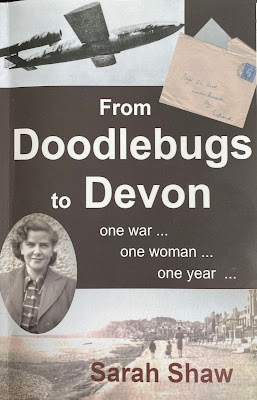 |
| Gotha Terror by Ian Castle cover (author's photo) |
Wednesday, 4 December 2024
Gotha Terror: The Forgotten Blitz 1917-1918 by Ian Castle
Thursday, 15 February 2024
From Doodlebugs to Devon - by Sarah Shaw
 |
| From Doodlebugs to Devon cover (author's photo) |
Monday, 22 January 2024
Book Review - "Unbroken Glory" The Great War Story of Anson Battalion, The Royal Naval Division by Dr Robert Wynn Jones
This is Dr
Jones’ second foray into the world of military history and as with his first
book, “Soldiers and Sportsmen All”, the subject matter has a definite family
connection for the author, as his paternal grandfather, Able Seaman Francis
Wynn Jones served in both the Nelson and Anson Battalions of the Royal Naval
Division, spending the final eight months of the war in captivity, having been
captured on 23 March 1918, during the German Spring Offensive.
The author
begins by explaining the raison d’etre of
the Royal Naval Division and telling us something of his paternal grandfather, who
in normal life was a Post Office clerk in London, although he hailed from
Llandrillo in North Wales.
The book
charts the formation of the Royal Naval Division, which immediately became
known to some as “Churchill’s Private
Army” or perhaps worse as the “Tuppeny
untrained rabble” and explains the makeup of the various battalions, all
named after Royal Navy heroes of the past and how, perhaps confusingly to those
on the outside, the men all retained their naval ranks, ensuring that Able
Seaman, Leading Stokers and Chief Petty Officers could be found far away from
their usual maritime locations!
A wider
description of the war on the Western Front follows, with interesting
comparisons of the arms, equipment and organisation of the combatant nations
involved, as well as a good description of how life on the Western Front would
have been for the typical British soldier in the dugouts and trenches along the
front line – “either frightened to death
or bored to tears” – as one contemporary account succinctly put it.
The bulk of
the remainder of the book is taken up with descriptions of the various actions
that the Division were involved with starting with the ultimately unsuccessful
attempt to defend Antwerp, followed by the Gallipoli and Salonika Campaigns,
before we return to the various campaigns on the Western Front that occupied
the Division for the remainder of the war, culminating in the German Spring
Offensive of 1918 and the Allied “Hundred Days” Offensive that resulted in the
ultimate German collapse. The author vividly describes not only the Anson
Battalion’s involvement but also the battles in the wider context of the war
and has drawn not only from War Diaries but also from contemporary publications
and letters from those involved.
The author
has visited many of the battlefields himself and as any of us who have trodden
the ground can testify, has found it often to be a profoundly moving
experience.
The book
concludes with an extensive and comprehensive series of maps, photographs and
biographical sketches of men from the Anson Battalion, as well as a chapter
covering the life of the author’s paternal grandfather (or “Taid) Francis Wynn Jones. Without wishing to give away too many “spoilers”,
we last heard of Wynn, as he was universally known, ending the war in captivity
but before this was confirmed, he had in fact been posted as “missing” on the Flesquieres-Havrincourt
Salient on 23 March 1918 and it was not until over a month later on 25 April,
that word was received that he was still alive and was being held in captivity.
The author’s
description of his grandfather as an elderly man, whom he regularly met during his
childhood in the late 1960s, is heart-warming and ends this book on a suitably
optimistic note.
As with this author's previous military history volume, this is a well-research and fascinating read which I have no
hesitation in recommending to you.
Available
from www.amazon.co.uk
RRP £9.99
softback,
pp 314

